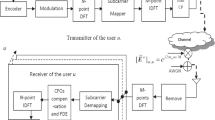Abstract
In this paper, we develop a new joint estimator for the Ricean K-factor and the signal-to-noise ratio (SNR) when multiple antenna elements receive linearly-modulated signals with a complex additive white Gaussian noise spatially uncorrelated. The fourth-order cross-moments and the second-order moments of the received signal at a single-input multiple-output (SIMO) system are considered. The SNR is deduced by estimating the powers of the useful signals and the noise. While the K-factor is computed by estimating the kurtosises of the transmitted data and the Ricean channel. The new joint estimator is non-data-aided and does not require the a priori knowledge of the modulation type or order. The performances of this algorithm are investigated in terms of normalized root mean square error over different modulated transmissions and compared with the data-aided auto-correlation function (DA-ACF) based joint estimator extended to a SIMO configuration. Simulation results show that our approach outperforms the DA-ACF estimator.





Similar content being viewed by others
Notes
Note here that we do not make any assumption about the statistical model of the diffuse component of Ricean channel model. So, we avoid any a priori knowledge about the statistical model of \(\tilde{c}_i\). Of course, it has to be zero mean complex Gaussian process.
For the SNR estimation, we first estimate the noise power at each antenna element, then, we average it over all antenna elements.
Of course, we can use an \(\omega _m\) estimator among the literature (see [18] and references therein) and combined with DA-ACF one, but this increases the overall computational complexity.
These parameters correspond to narrowband channels.
References
Stüber, G. L. (2001). Principles of mobile communication (2nd ed.). Boston: Kluwer.
Steele, R., & Hanzo, L. (1999). Mobile radio communications: Second and third generation cellular and WATM systems (2nd ed.). New York: Wiley.
Simon, M. K., & Alouini, M. S. (2000). Digital communication over fading channels: A unified approach to performance analysis (2nd ed.). New York: Wiley.
Cui, T., Tang, J., Gao, F., & Tellambura, C. (2011). Moment-based parameter estimation and blind spectrum sensing for quadrature amplitude modulation. IEEE Transactions on Communications, 59(2), 613–623.
Tepedelenlioglu, C., Abdi, A., & Giannakis, G. B. (2003). The Ricean K-factor: Estimation and performance analysis. IEEE Transactions on Wireless Communications, 2(4), 799–810.
Azemi, G., Senadji, B., & Boashash, B. (2004). Ricean K-factor estimation in mobile communication systems. IEEE Communications Letters, 8(10), 550–560.
Baddour, K., & Willink, T. (2008). Improved estimation of the Ricean K-factor from I/Q fading channel samples. IEEE Transactions on Wireless Communications, 7(12), 5051–5057.
Ramesh, A., Chockalingam, A., & Milstein, L. B. (2002). SNR estimation in Nakagami-m fading with diversity combining and its application to turbo decoding. IEEE Transactions on Communications, 50(11), 1719–1724.
Beaulieu, N. C., & Chen, Y. (2005). Maximum likelihood estimation of local average SNR in Ricean fading channels. IEEE Communications Letters, 9(3), 219–222.
Chen, Y., & Beaulieu, N. C. (2007). Estimation of Ricean K parameter and local average SNR from noisy correlated channel samples. IEEE Transactions on Wireless Communications, 6(2), 640–648.
Bousnina, I., Ben Salah, M. B., Samet, A., & Dayoub, I. (2012). Ricean K-factor and SNR estimation for M-PSK modulated signals using the fourth-order cross-moments matrix. IEEE Communications Letters, 16(8), 1236–1239.
Bousnina, I., Bellili, F., Samet, A., & Affes, S. (2011). Joint estimation of the Ricean K-factor and the SNR for SIMO systems using higher order statistics. In Proceedings on IEEE GLOBECOM (pp. 1–5). Houston, TX, USA, Dec. 2011.
Felhauer, T., Baier, P. W., König, W., & Mohr, W. (1994). Wideband characterisation of fading outdoor radio channels at 1800 MHz to support mobile radio system design. Wireless Personal Communications, 1(2), 137–149.
Ziółkowski, C., & Kelner, J. M. (2015). Geometry-based statistical model for the temporal, spectral, and spatial characteristics of the land mobile channel. Wireless Personal Communications, 83(1), 631–652.
Bingham, J. A. C. (1990). Multicarrier modulation for data transmission: An idea whose time has come. IEEE Communications Magazine, 28(5), 5–14.
Wang, Z., & Giannakis, G. B. (2000). Wireless multicarrier communications: Where Fourier meets Shannon. IEEE Signal Processing Magazine, 17(3), 29–48.
Stéphenne, A., Bellili, F., & Affes, S. (2010). Moment-based SNR estimation over linearly-modulated wireless SIMO channels. IEEE Transactions Wireless Communications, 9(2), 714–722.
Ben Rejeb, N., Bousnina, I., Ben Salah, M. B., & Samet, A. (2015). Mean angle of arrival, angular and Doppler spreads estimation in MIMO system. IET Signal Processing, 9(5), 395–402.
Ben Salah, M. B., & Samet, A. (2015). Modulation identification using moment features for communications via Ricean fading SIMO channels. Wireless Personal Communications, 83(4), 2683–2692.
Author information
Authors and Affiliations
Corresponding author
Rights and permissions
About this article
Cite this article
Ben Salah, M.B., Samet, A. Moment-Based Joint Estimation of Ricean K-Factor and SNR Over Linearly-Modulated Wireless SIMO Channels. Wireless Pers Commun 91, 903–918 (2016). https://doi.org/10.1007/s11277-016-3503-6
Published:
Issue Date:
DOI: https://doi.org/10.1007/s11277-016-3503-6




